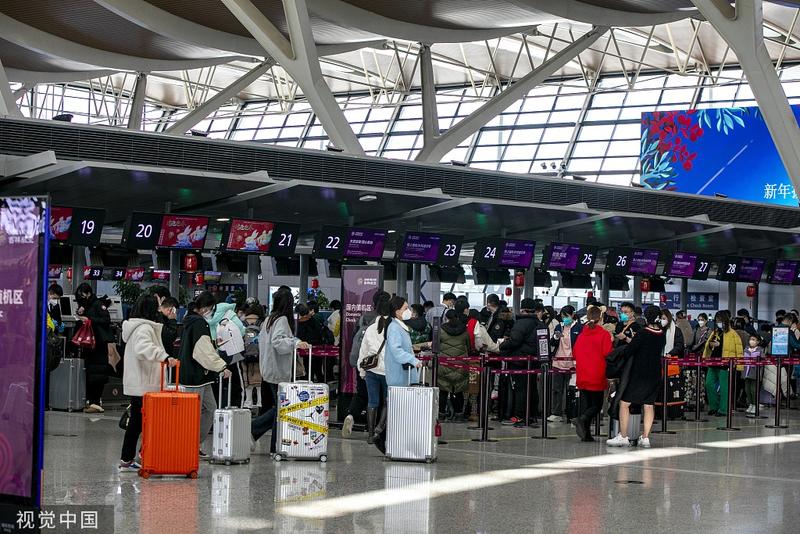 Passengers wait in a line for check-in at the Shanghai Pudong International Airport on Jan 8, 2023. (PHOTO / VCG)
Passengers wait in a line for check-in at the Shanghai Pudong International Airport on Jan 8, 2023. (PHOTO / VCG)
China has passed its recent peak COVID-19 period for fever clinic and emergency room visits and intensive care unit admissions, and concerted efforts are being made to protect the nation's vast rural areas against the disease ahead of a major holiday, officials said on Thursday.
Guo Yanhong, head of the National Health Commission's medical emergency department, said the number of people hospitalized with severe COVID-19 cases crested on Jan 5 and then began declining.
The numbers of fever clinic and emergency room visits peaked on Dec 23 and Jan 2, respectively, and have steadily declined since, Guo said at a news conference.
China began optimizing its COVID-19 control policy in late November and downgraded management of the disease from Class A to Class B on Jan 8.
"Currently, treatment of COVID-19 patients is steady and orderly, and regular medical services are gradually returning to normalcy," Guo said.
She said that signs of the transition back to regular healthcare services include the decreasing number of COVID-19 cases among outpatients and hospitalized patients, and the rising number of surgeries since early January.
However, officials noted that grassroots medical institutions, especially those in rural areas, recently grappled with a shortage of equipment.
To prepare for a potential spike in infections, fueled by the increase in travel during the Spring Festival holiday, officials emphasized that more support will be given to building medical capacity and stockpiling drugs.
Mao Dezhi, an official with the Ministry of Agriculture and Rural Affairs, said that 32 groups have been sent by the State Council to help address shortages of health workers and medicines in the countryside.
Over 1.17 million pulse oximeters have been sent to 600,000 rural clinics nationwide, he said. The first shipments of oxygen generators for 832 previously impoverished counties have reached their destinations and the delivery of more began on Tuesday, he added.
"We are also working with the Ministry of Industry and Information Technology and the National Health Commission to supply rural areas with pain medicines," he said, pledging to devote "all-out efforts to resolving all kinds of shortages" in rural areas.
In addition to stocking up on daily necessities and medical supplies, Mao said that localities had finished surveying 590 million rural residents to assess the health conditions of the elderly, pregnant women, children and other vulnerable groups.
Rural officials have been instructed to mobilize volunteer teams to facilitate the transfer of severely ill patients to higher-level hospitals, and prepare first-aid personnel and vehicles in advance, he said.
Guo, the medical emergency department head, said that over 99 percent of township-level health centers have set up a fever station, and the strains on drug supplies and medical workers have been eased.
Chang Zhaorui, a researcher at the Chinese Center for Disease Control and Prevention, said the hybrid "Deltacron" variant — a strain that contains elements of the Delta and Omicron variants and is officially named XAY.2 — has not been detected on the Chinese mainland.
The recombinant strain was first identified in South Africa on Aug 31, and has since been found in nine countries and regions. Denmark and a few other countries have reported rising XAY.2 infections since December, but data on its transmissibility, pathogenicity and immune evasiveness is lacking.


